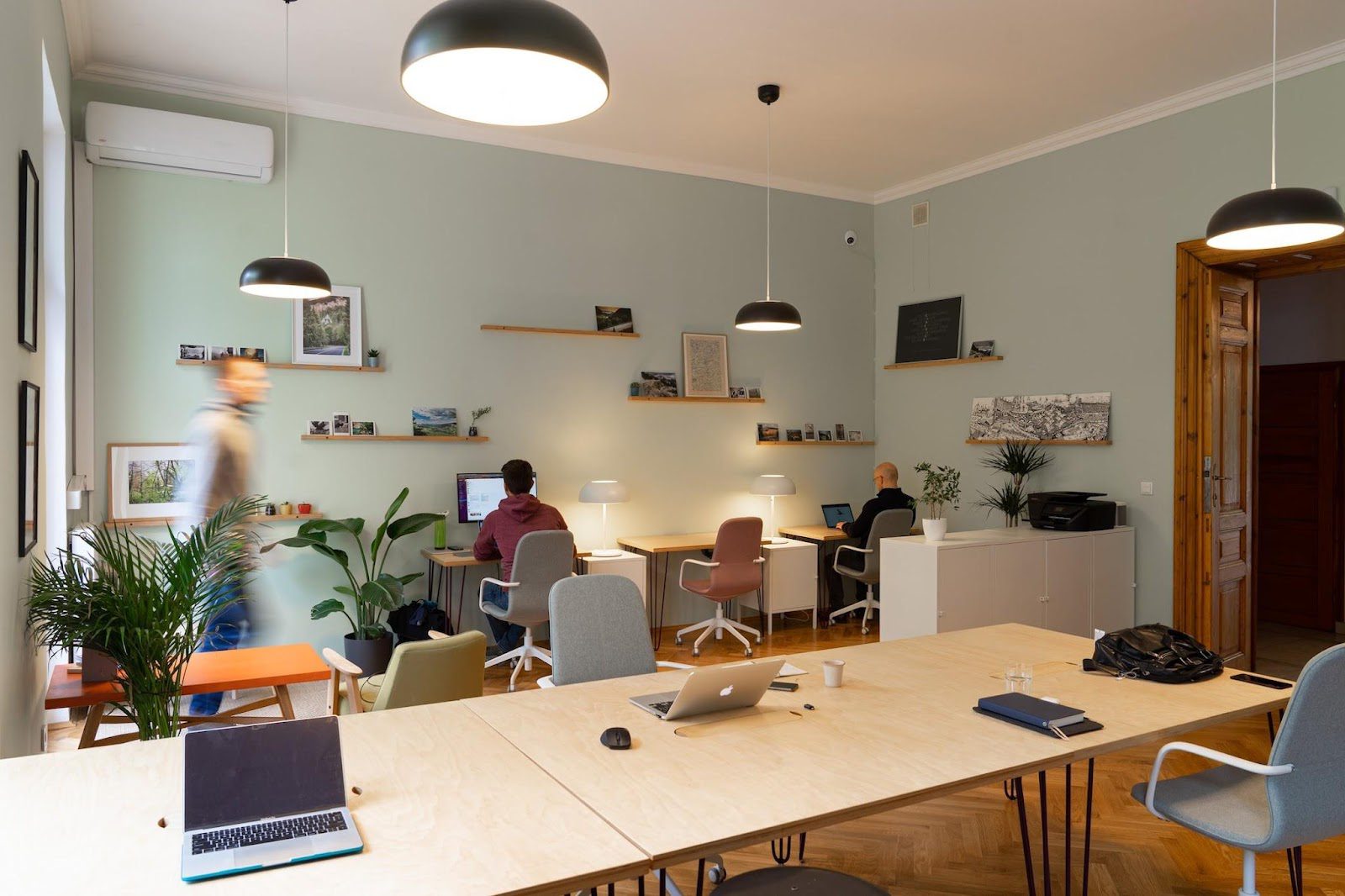Are you feeling the tug of entrepreneurial life calling but not quite sure where to start? You’ve heard of co-working spaces, but what do they mean for aspiring business owners who are just getting their feet wet in the wide world of creating something from nothing?
This comprehensive guide is here to give you an overview of how and why co-working spaces have evolved over time and provide practical tips on how to make the most use of them as well. With a little bit of initiative and guidance, every entrepreneur can create a productive workspace that meets their needs — let’s take the first steps together!
What Is Co-working: An Introduction
Co-working is a concept that has gained popularity in recent years, and for good reason. It is essentially a shared workspace where individuals from various professions and industries come together to work in a collaborative environment.
Co-working spaces offer a lot more than just a physical workspace: they provide an opportunity for individuals to network and connect with others who share similar goals and interests. Co-working spaces often offer amenities like high-speed internet, meeting rooms, and printing facilities, making it an attractive option for freelancers, entrepreneurs, and small business owners who are looking for an affordable and flexible workspace. Co-working spaces have become a hub for innovation and creativity, and it’s no surprise that they have become a popular choice for many individuals looking for a more engaging work experience.
How to Choose the Right Co-working Space
With so many options available, choosing the right co-working space can be a daunting task. Here are some factors to consider when making your decision:
- Cost: Determine how much you’re willing to spend on a co-working space. Consider the amenities and benefits that come with each membership option to ensure you’re getting the best value for your money.
- Community: Research the community within the co-working space, their values, and how they can align with yours. A supportive and collaborative community can make all the difference.
- Amenities: Determine what amenities are important to you, whether it’s high-speed internet, meeting rooms, or a gym. Some co-working spaces may offer more perks than others, so consider your needs and priorities.
- Flexibility: Consider the different membership options available and how they can meet your specific needs. Also, check if there are any additional fees for amenities or services that you may require.
And don’t forget about location — if you’re looking for a place to work that’s not in the confines of your home, a co-working space might just be what you need. If you are from the area, a Sydney co-working space might be the perfect fit for you. These spaces are usually located in strategic locations close to public transportation, making it easy for individuals to access them. They also tend to have a vibrant and dynamic community of like-minded individuals who can provide support and motivation.
The Rise of Co-working Space
Co-working spaces are a rapidly growing trend in our modern workforce. However, the concept of shared office space is not a new one. Co-working can be traced back to the early 2000s when tech startup companies in San Francisco began to share workspace to cut down on expenses. From there, the trend quickly spread to other cities and industries, leading to the creation of dedicated co-working spaces and even entire co-working communities. As our workplaces continue to evolve, it is clear that co-working is not just a trend but a necessary solution for the changing needs of our modern workforce.
Advantages of Co-working Spaces
One of the biggest advantages of co-working spaces is the sense of community and collaboration that they provide. Working alongside like-minded individuals creates an environment where ideas can be shared, knowledge can be gained, and partnerships can be formed. That aside, there are other benefits that come with working in a co-working space:
- Flexibility: Co-working spaces offer flexible rental options, allowing individuals to choose how often they want to use the workspace and for how long. This is especially beneficial for freelancers or those who need a temporary workspace.
- Cost-effective: Renting an office space can be expensive, especially for entrepreneurs just starting. Co-working spaces offer affordable options and often come with additional perks like free coffee, printing services, and access to networking events.
- Networking opportunities: Co-working spaces attract a diverse group of individuals from different industries, offering great potential for networking and collaboration. This can lead to new business connections, partnerships, and even clients.
- Work-life balance: Working from home can blur the lines between work and personal life, making it difficult to disconnect. Co-working spaces provide a dedicated workspace, allowing for a better work-life balance.
- Increased productivity: With a professional and collaborative environment, co-working spaces can provide the motivation and accountability that individuals need to be productive. They also offer access to various resources and amenities that can aid in productivity.
- Opportunity for growth: Co-working spaces often have resources and programs in place to support the growth of their members. Whether it’s mentorship, workshops, or networking events, these opportunities can help individuals take their businesses to the next level.
In short, co-working spaces provide a solution for modern professionals seeking a professional and social environment to foster their creativity and grow their businesses.
Traits of Successful Co-working Spaces
Successful co-working spaces have certain characteristics that distinguish them from the rest. Let’s take a closer look at each.
Well-designed Spaces
A well-designed co-working space is about more than just aesthetics; it’s about creating a workspace that fosters productivity and collaboration, including a thoughtful layout that allows for both private and shared work areas, comfortable seating, plenty of natural light, and quiet areas for focus work.
Successful co-working spaces should also be equipped with the necessary technological infrastructure such as high-speed internet, meeting rooms with video conferencing facilities, and easy access to printing and photocopying services. The design and facilities should inspire creativity and productivity, making members feel comfortable and motivated to work.
Vibrant Community
A vibrant community is the lifeblood of any successful co-working space. Besides gathering a group of people in the same space, you can create an environment where members feel a sense of belonging and support. These spaces should facilitate networking and collaboration through events and meetups, fostering a culture of knowledge sharing and mutual growth. A dynamic community can lead to partnerships, friendships, and opportunities, making the co-working experience more enriching for members.
Access to Resources and Amenities
Fulfilling the needs of its members is crucial for a co-working space’s success, offering resources and amenities that can aid their work and make their experience more comfortable. These can range from basics like high-speed internet, office equipment, and kitchen facilities to more premium offerings like on-site fitness centers, relaxation zones, or even in-house cafes. Some co-working spaces also provide educational resources, such as workshops, speaker events, or mentorship programs, to support the professional growth of their members.
Flexibility
Users should have the liberty to choose from various membership options that cater to their specific needs, be it daily passes, monthly memberships, or long-term contracts. The space should also accommodate different types of work scenarios, from individual workstations to group meeting rooms. Moreover, considering the varying schedules of its members, a successful co-working space should provide 24/7 access, allowing individuals to work at their own pace and at times that suit them best. This level of flexibility can make a significant difference, appealing to a broader range of professionals and making the co-working space a more inclusive environment.
Maximizing Productivity in Co-working Spaces
Co-working spaces have taken off in popularity over the last decade, with more and more entrepreneurs and freelancers opting to work in these communal environments. With the benefits of networking, access to professional amenities, and a sense of community, co-working spaces can be incredibly appealing. However, it can be easy to become distracted or unmotivated in such an open and social environment, ultimately hindering your productivity levels. So, how can you maximize your productivity in co-working spaces? Here are a few tips:
- Find your perfect spot: Whether it’s a quiet corner or a bustling communal area, find the space that works best for you and your work style. Experiment with different areas until you find one that suits your needs.
- Set boundaries: With the potential for networking opportunities and social interactions, it’s essential to set boundaries and manage your time effectively. This will allow you to balance socialization with getting your work done.
- Take breaks: It’s essential to take short breaks throughout the day to recharge and refocus. Go for a walk, grab a coffee, or chat with other members in the kitchen area. Taking breaks can actually improve productivity levels.
- Use time management techniques: Techniques like the Pomodoro method, where you work for a set amount of time and then take short breaks, can help improve focus and productivity.
- Engage with the community: Don’t be afraid to network and get to know your fellow co-workers. You never know what opportunities or insights you could gain from these interactions.
- Be organized: A cluttered workspace can lead to a cluttered mind. Keep your workspace tidy and organized, making it easier for you to focus on your work.
With these tips, you can make the most out of your co-working space experience and maximize productivity levels. Of course, everyone works differently, so find what works best for you and embrace the collaborative environment that co-working spaces offer.
The Impact of Technology on Co-working Spaces
As technology continues to rapidly evolve and become increasingly integrated into our daily lives, we’re seeing it make an undeniable impact on the coworking industry. Once viewed as simply a trendy alternative to traditional offices, coworking spaces are now being seen as essential for fostering creative collaboration and innovation. The rise of technology has played a significant role in shaping the coworking landscape, and there’s no doubt that it will continue to do so.
Remote Work and Digital Nomads
One of the main drivers behind the growth of coworking spaces is the rise of remote work and digital nomadism. With advancements in technology, individuals are no longer bound by a physical office space and can work remotely from anywhere in the world. This has led to a growing number of remote workers and digital nomads seeking out coworking spaces as their preferred workspace.
Mobile Apps and Automation
Technology has also played a significant role in streamlining operations within co-working spaces, making them more efficient and user-friendly. With mobile apps, members can easily book meeting rooms, reserve desks, and make payments all from the convenience of their phones. Automation has also been introduced in many co-working spaces, simplifying tasks like checking in and out or managing access to specific areas within the space.
Virtual Co-Working Spaces
With the rise of video conferencing and virtual collaboration tools, co-working spaces are no longer limited to a physical location. Virtual co-working spaces have emerged, offering individuals the opportunity to connect and work with others from anywhere in the world. These spaces provide access to shared online platforms, allowing for real-time communication and collaboration among its members.
Co-working is gaining popularity rapidly, and it’s evident that the trend will continue in the coming years. Thanks to this concept, many companies have been able to cut costs, improve collaboration, and enhance productivity.
Artificial Intelligence and Smart Workspaces
As we continue to see advancements in artificial intelligence and machine learning, it’s no surprise that these technologies are also making their way into co-working spaces. From chatbots that assist with bookings and inquiries to smart lighting and temperature control systems, AI is being used to enhance the user experience and improve overall efficiency within co-working spaces.

The future of co-working will be shaped by new trends that are already emerging. For instance, we’re likely to see more spaces for remote workers, the incorporation of wellness services like gyms and meditation rooms, and the use of artificial intelligence to personalize the co-working experience. It’s also likely that we’ll see more flexible spaces that will allow workers to choose how much time they spend in the office and how much they work remotely. Truly, the future of co-working is exciting, and we’re looking forward to seeing these trends unfold.



































